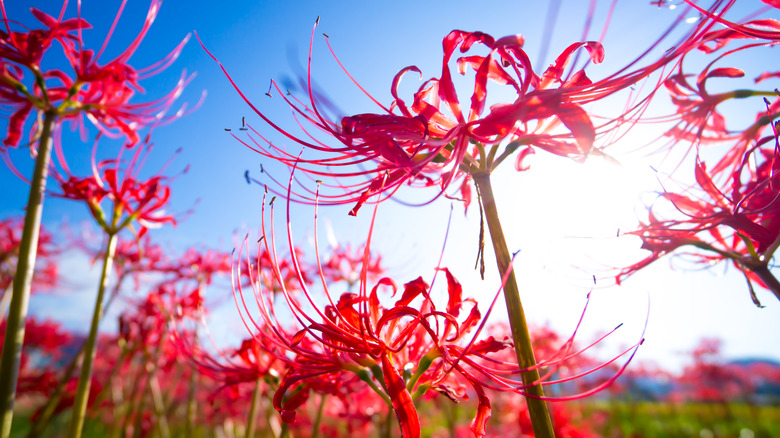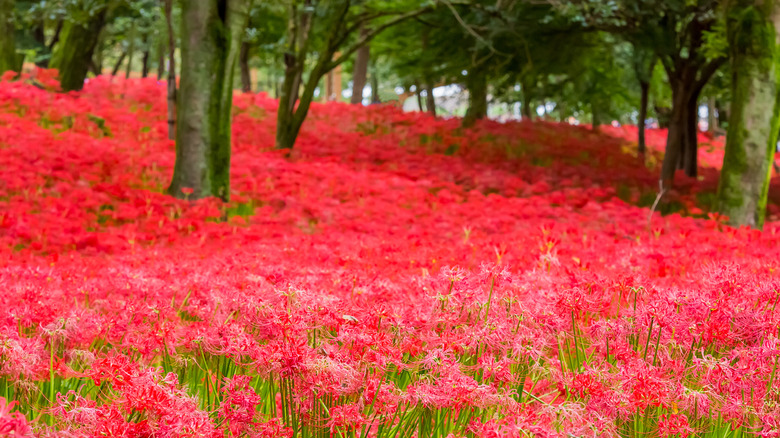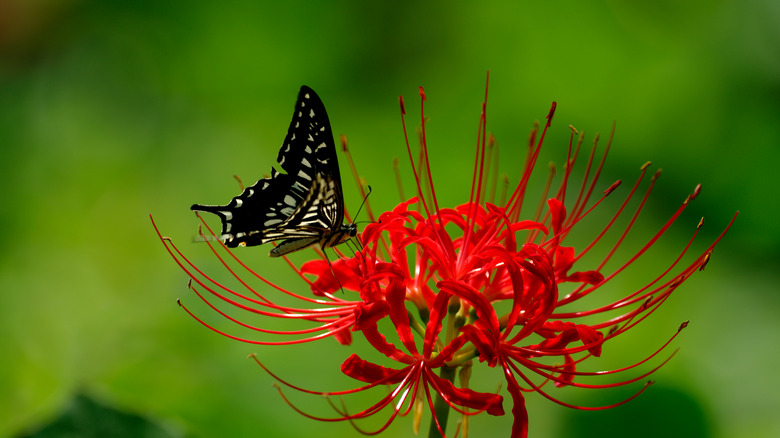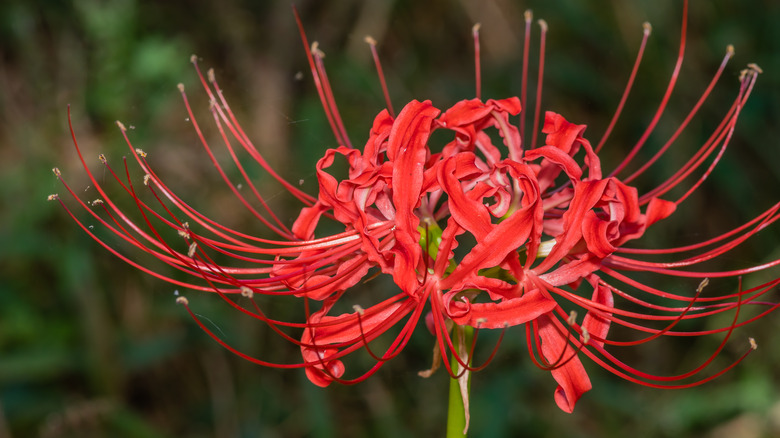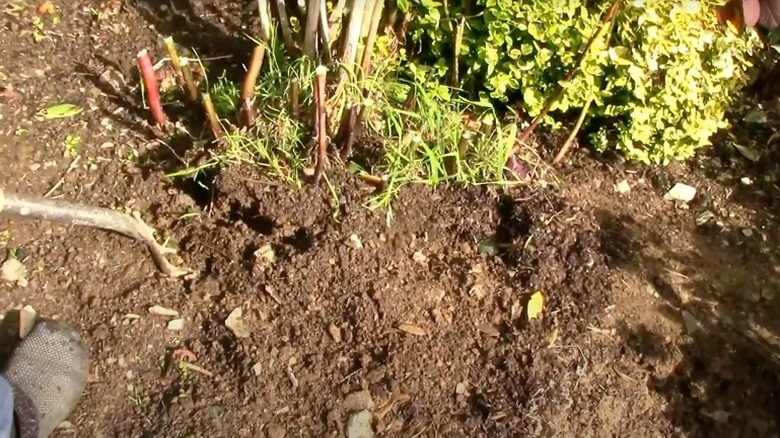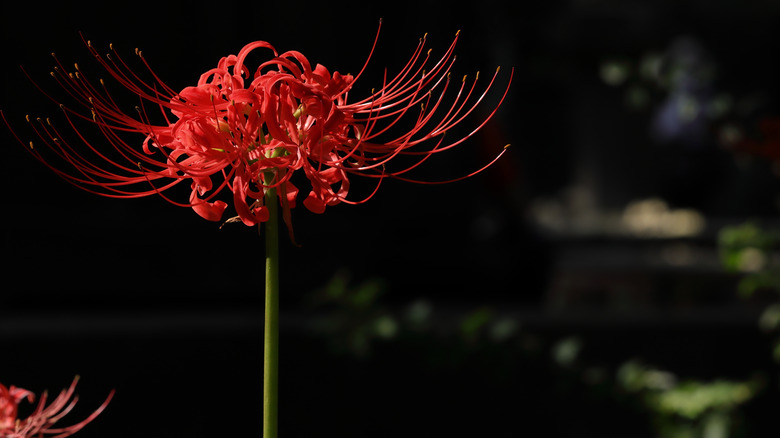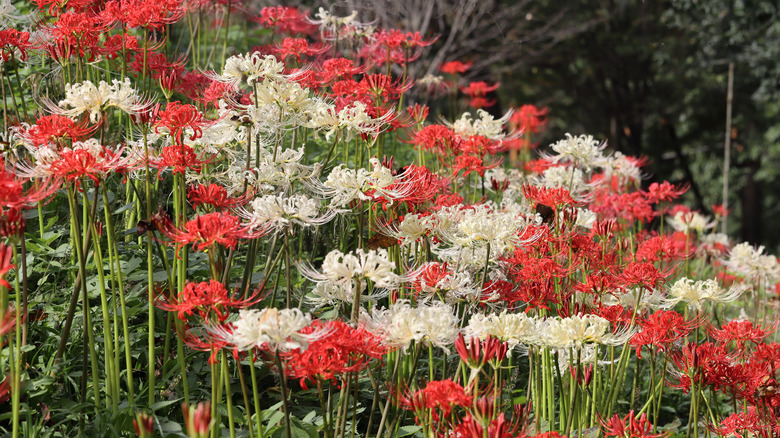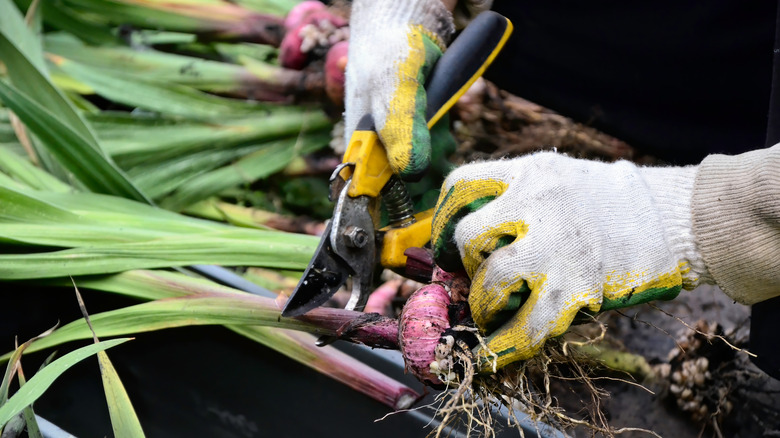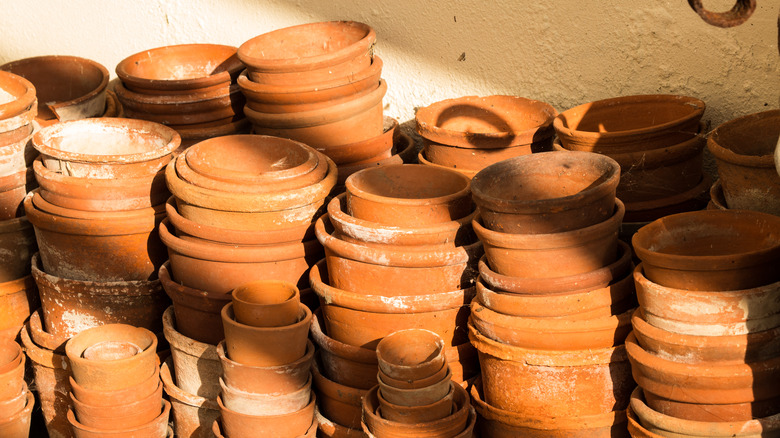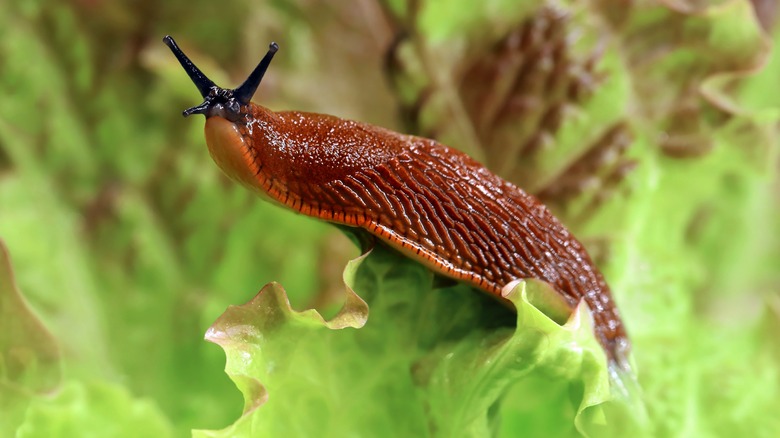Red Spider Lily: Everything You Should Know Before Planting
The red spider lily goes by many different names. Known scientifically as Lycoris radiata, the red spider lily is part of the amaryllis family and also goes by the names equinox flower, red magic lily, and hurricane lily. The history of the red spider lily is a somber one, but crucial to understanding some of the cultural traditions of its native Japan. In this country, mourners place red spider lily flowers on the graves of their departed loved ones, as per Epic Gardening. The flower was also used in the past to protect rice paddies from predators, such as mice, as it is highly toxic to animals. For those who believe in the mystical properties of the red spider lily, the flower is an important symbol of the afterlife and the reincarnation of the deceased soul.
Naturally, the plant earned its name due its resemblance to a spider. The multiple stamens emerging from each flower are eerily similar to the long, thin legs of this insect. Flowers grow to be around two inches in width while the entire plant reaches heights of between 1 and 2 feet, spreading to about 1.5 feet in width. Once planted, the red spider lily isn't a fussy organism and will reward you with its vibrant red colors during its yearly bloom season before returning to dormancy. Keep scrolling to learn more about this plant and how to take care of it!
How to use red spider lilies in your garden
The red spider lily will make a fantastic addition to any garden. It is a versatile plant to work with while its delicate flowers draw the eye with their luminous red color palette. Before deciding where to plant the red spider lily, it's worth noting that when the flowers bloom, they form a dense tapestry that gives the appearance of a joined bouquet of flowers rather than individual stalks, according to SF Gate. You can use this growing pattern to your advantage by dedicating an area of your lawn specifically to a pseudo-carpet of red spider lilies. Another idea for an ideal location to plant red spider lilies is around the base of trees, bushes, or other natural formations in your garden. They act as the perfect border plant that can add structure to your garden by delineating a path through your yard or around another group of plants and flowers.
If you prefer planting your red spider lilies among other flowers, there a couple of important notes to keep in mind. Firstly, the plant has an unusual bloom schedule. The red flowers emerge in the fall rather than the summer, which could leave your garden beds appearing sparse in the summer. You can get around this by interspersing your red spider lilies with spring or summer flowering plants, which will compensate for the lack of color from your red spider lilies until they are ready to bloom.
How red spider lilies can improve your garden
It's always a wonderful idea to include some of the best plants for pollinators in your garden, and Lycoris radiata does not disappoint. According to The Bulb Hunter, the red blooms are not particularly interesting to bees, however, moths, butterflies, and hummingbirds all love them. It's also worth noting that these flowers are deer-resistant as well, and maybe even a little squirrel-resistant. So they won't just attract the fauna you want — they'll deter those you don't.
Another aspect of red spider lilies that improves your garden is the fact that they add much-needed color in the fall. Just as the majority of your garden is dying and the colder temperatures threaten to nip at your nose, a bright red bloom pops up to make your day. Per Trees.com, you're likely to get several flowers from each stem, which will look great when set near other flowers with complementary colors. This will make them an excellent addition to your autumn border garden.
How to grow red spider lilies
When it comes to planting your red spider lilies, note that you will be placing bulbs in the soil in lieu of seeds, per Love to Know. The proper planting season is during the spring or summer. If you've decided to plant your red spider lilies in a flower bed or other free-standing location in your yard, you'll need a trowel to dig holes for each bulb and an optional pair of gardening gloves to protect your hands.
You also have the option of planting red spider lilies in containers. Be prepared to purchase a large pot or barrel that contains at least 18 inches of depth and is wide enough to allow for proper growth of the red spider lily's intricate root system. Consider the health of your garden soil before using it to fill your container. It is often recommended to purchase a high-quality potting mix, which will ensure that your red spider lily gets all the nutrients it needs. If your garden soil doesn't cut it, you can purchase a bag of nutrient-dense mulch to spread around your planted bulbs.
Once you've gathered the materials, start by digging holes in your garden that will cover each bulb up to the pointed tip, which should be facing up. You won't want to completely bury your bulbs, leaving each one partly visible above the soil. If planting more than one bulb, leave 8 inches of space between each hole. Water thoroughly after planting.
How to care for red spider lilies
Red spider lilies are sun gluttons and will need around six full hours of sunlight per day, as noted by Martha Stewart. The rest of the day can be spent in filtered or full shade. If red spider lilies receive more than six hours of direct sunlight, they run the risk of overheating and dying.
The watering needs of red spider lilies will depend on the time of year. During the active growing season when red spider lilies are flowering, you will need to water them more often. A good rule of thumb is to never let the soil completely dry out in between waterings. That said, overwatering is unhealthy for the red spider lily and can cause rot and other problems. When red spider lilies pass through their dormant periods, they still require some work on your part. Water less frequently, but ensure the soil never gets bone dry.
Soil requirements include well-draining soil types that are nutrient dense, according to Love to Know. The nutrients found in the soil should be enough to keep your red spider lilies health and happy, but you can occasionally add some fertilizer to give them a boost. You will need to take care not to fertilize your plants during an extended period of time after planting. Once your red spider lilies are showing evidence of growth, you can sprinkle a bit of 5-10-10 fertilizer every eight weeks or so during bloom season.
When and how to divide red spider lily bulbs
Dividing bulbs is a very similar process to rhizome or root division. You'll likely be able to do it all by hand, except for the digging part, which will definitely call for a shovel. With some particularly thick or large bulbs, you might find you'd like to use garden shears or a small cutting implement. If that's the case, just be sure they've been adequately cleaned and disinfected so as not to run the risk of spreading any diseases.
In their very helpful YouTube tutorial on propagating lily bulbs, the folks from Gardening at Douentza say to start the process in either late summer or early fall. Make a wide perimeter around the bulbs in your garden and carefully dig out the whole clump. Cut back each lily spike almost all the way down to the bulb. From there, it's a piece of cake. You'll just break off the bulbs into smaller pieces and replant each of them as soon as possible.
How to propagate red spider lilies by seed
Bulb division is the standard propagation method for red spider lilies, but they can also be grown by seed. The seeds will go dormant in the summer, so refrain from planting them at the end of spring. You want to take care of this task immediately after collecting the seeds, preferably when the temperatures are hovering around 70 degrees Fahrenheit.
Raya Garden states that sowing seeds is not advisable for indoor container plants. Use this method when planting in your garden or working on a larger landscaping project outside. The biggest drawback to sowing red spider lily seeds is that very few of your seedlings are likely to succeed and produce radicles, which Britannica defines as primary roots, or "the first organ to appear when a seed germinates." Radicles grow down into the soil to provide an anchored base for the seedling that will then shoot up. With a bit of luck, you should see this begin to happen after about 15 days. However, don't expect to see flowers from your new little plants for another four to five years.
How long does it take for red spider lilies to bloom?
The blooming patterns of red spider lilies are different than most other flowers. On the one hand, patience is a virtue when planting these lilies; on the other hand, prepare to be surprised. Southern Bulb Company explains that newly planted bulbs will take a minimum of a year to bloom, but more likely closer to two years. Remember that they go dormant in summer, so you won't see any red spider lily growth for the entire season when most of your other flowers are enjoying their moment to shine. It's possible that you'll see foliage from the planted bulbs the first winter, but it's not something to worry about if you don't.
Basically, you plant the bulbs and let them do their thing. Then in about two years, suddenly, one day — usually after a massive autumn rain — you have a stunning flush of bright red blooms. That may seem like a long time to wait, but really it's nothing when compared to the sown seed method of propagation, which Raya Garden says can be as long as five years.
The finicky flowers have been known to skip a year of blooming unexpectedly. Whenever you're lucky enough to experience a garden full of red spider lily blossoms, they stick around for about two weeks.
Where can you buy red spider lilies?
If you look for Lycoris radiata bulbs at a general home improvement center like Home Depot or Lowe's, you might come up empty-handed because it's not the most common or popular plant. While it's possible that they would be happy to order them for you, they'll just be acting as a middleman between you and a bulb company.
Your best bet for tracking down quality red spider lily plants is to visit a local nursery or, better yet, go directly through a bulb-specific retailer, such as Holland Bulb Farms or Southern Bulb Company. Horticulturists at these nurseries know their bulbs the best and put a tremendous amount of time and effort into creating a quality product. Furthermore, if you order directly from them, your bulbs will suffer through the least amount of potentially bumpy handling and transit.
The Southern Bulb Company notes on their website that one of the reasons these initially fussy flowers don't bloom in the first year is because the bulbs have been out of the ground for too long. Another reason to work with a bulb company is the expediency of transit and delivery times.
Varieties of red spider lilies
Red spider lilies are a part of the Lycoris genus, which is comprised of around 20 species of plants, as reported by A to Z Flowers. All Lycoris species originated in East Asia, with many native to the countries of Japan and China. The red spider lily is no exception and features heavily in Japanese culture. While many varieties of spider lilies share the same characteristics, such as the spider-leg-like tendrils that emerge from each bloom head, they also come in an array of different colors, which can add a rich color palette to your garden if you choose to incorporate more than one variety.
Among the 20 species of Lycoris plants is the Lycoris aurea, which is identifiable by its golden blooms, according to Trees.com. The blooms share the long, scrawny stamens of the red spider lilies as well as the curled appearance of the petals. Another variety is known as Lycoris squamigera, which has pink petals. Unlike other varieties, the Lycrois squamigera does not feature a spider-like appearance. Similarly, Lycoris sprengeri features solely oblique and slightly curled petals without the presence of multiple stamens along the exterior of the bloom. Also pink in color with lavender tips, this variety is a beautiful addition to any garden. One more variety that shares nearly all the same characteristics with the red spider lily is the Lycoris albiflora. The only difference is that it is white in color.
When to prune red spider lilies
When it comes to bulb plants like the red spider lily, experts at Trees.com say that pruning can hurt more than help. It may sound counterintuitive until you remember that bulbs are a classification unto themselves. Garden bloggers Brent & Becky's Bulbs elaborate on this by explaining yes, you can prune bulbs, however, it's crucial to get the timing right. The leaves do the very important job of harnessing energy from the sun that then gets transformed into energy to feed the roots and bulbs. Prematurely cutting back unsightly leaves can interrupt the natural cycle, thus causing unintentional harm to the plant.
Wait a full two months for flowers to stop blooming before proceeding with any trimming. Cut back only the leaves that have faded to yellow or fallen over. Once blooms are spent, go ahead and do some deadheading in the garden to remind the plants to send their energy back down to the bulbs.
A well-cared-for spider lily plant can live for decades. Calling them enduring perennials, HGTV explains that as long as the bulbs are being divided at least every seven years, they'll continue to flourish and offer their delightful blooms.
How to repot red spider lilies
If you've chosen to plant your red spider lilies in containers or pots, you may wonder if and when you'll need to repot your bulbs. Ideally, you will never need to repot your red spider lily as this plant does not like being moved and may cease to thrive entirely if repotted, cautions Epic Gardening. When you first plant your bulbs in a container, the circumference and depth should be sufficient to house the complex root system of the red spider lily for its entire lifetime. However, if you happen to choose a pot that turns out to be too small for your red spider lily, it may be necessary to repot it.
Signs that your red spider lily needs a bigger home are if its roots are emerging from the drainage holes or if it has ceased to grow and bloom. In this case, take care to disturb the plant and its roots as minimally as possible. Since the root system of this plant is large, you'll need to make sure you don't separate any of the roots when you pull it up from the container. Make sure that you have chosen a container with enough space to home your red spider lily, including 18 inches of depth, as per Love to Know. When you're done transferring your red spider lily, water abundantly. Keep in mind that due to being disturbed, your red spider lily may not bloom fully the following season.
Potential pests and plant diseases
For the most part, red spider lily plants are pest- and disease-resistant, but there are a few issues to look out for, like root rot and slugs. Root rot is best avoided by taking care not to overwater your garden and always ensuring that the soil drains properly. When it comes to slugs, Green Ideas offers the nifty solution of pouring them a beer. Apparently, the slugs will be attracted to the ale but then get clumsy and end up drowning in it.
Lily disease is a much more serious condition involving fungal and viral infections of the leaves and bulbs. You'll know something is wrong if you see brown or yellow spots on the leaves, prematurely shriveling flowers, or rotting bulbs, explains Thompson & Morgan. Treatment must begin as soon as possible by removing and destroying any affected parts of the plant. Two final notes from Thompson & Morgan are to clean and disinfect your gardening tools with a strong bleach solution, and never throw diseased plant material in with the compost. Those fungal spores are very hard to kill by design, and you could inadvertently infect other plants.
Is the red spider lily toxic?
In short, yes, the red spider lily is toxic. The plants contain a toxin known as lycorine, which is poisonous when ingested, according to SF Gate. The plants were originally used to kill pests that invaded crops and homes in Japan, as per Epic Gardening. While most wild animals know not to ingest the bulbs of the red spider lily, household pets may not be able to recognize the danger. Accidental ingestion can lead to gastrointestinal issues, including vomiting and diarrhea, as noted by A to Z Flowers. In some cases, this plant can also lead to death when ingested in large quantities. Although it is less likely that children will accidentally consume this plant, it is also important to note that its toxic nature extends to humans as well, and care should be taken to keep young children and pets away from red spider lilies.
If you'd still like to plant red spider lilies in your garden but are worried about your pets' safety, OMYSA recommends that toxic plants should be planted in an off-limits area of your yard. You may want to consider fencing or another barrier to keep your pets away from your red spider lilies. Another solution is to use a spray repellant on your plants that will discourage your pets from eating them. Finally, consider training your pets to avoid the areas where red spider lilies grow by utilizing the methods of positive reinforcement.
